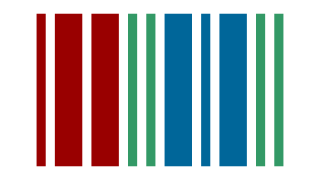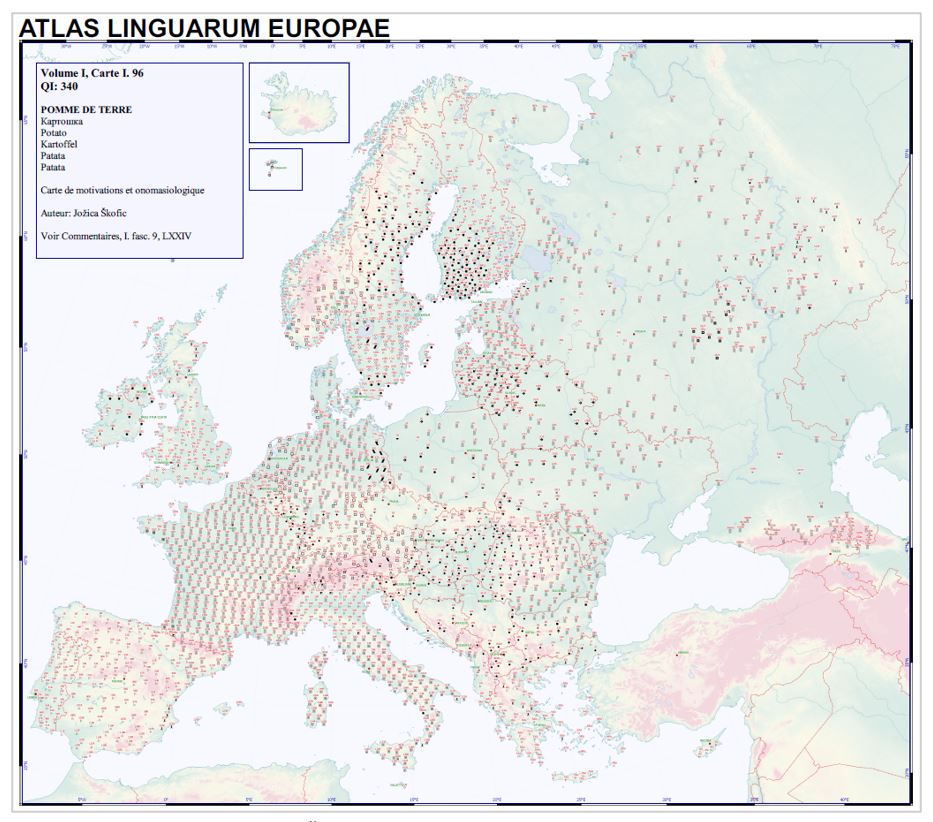##Kommentare und Korrekturen durch Christina Mutter##
##Kommentare und Korrekturen durch Thomas Krefeld##
##Kommentare und Korrekturen durch Stephan Lücke## - FERTIG
The article focuses on the interoperability of research data in ## the ?## Slovene Linguistic Atlas (SLA)##"Slovene Linguistic Atlas"## and VerbaAlpina##"VerbaAlpina"#### link to https://www.verba-alpina.gwi.uni-muenchen.de/ ?? Accordingly passim, e. g. OLA, ALE etc. ; add VerbaAlpina to bibliography? ##, and compares them with some other dialectological and geolinguistic projects, i. e. ## the ? ## Slavic Linguistic Atlas##"Slavic Linguistic Atlas"## (OLA ## include in bibliography and insert interactive citation ?? ##) and ## the ? ## European Linguistic Atlas##"European Linguistic Atlas"## (ALE).
1. Introduction
Slovene dialects are part of many international linguistic and interdisciplinary projects, such as VerbaAlpina##"VerbaAlpina"##, i.e. Slavic Linguistic Atlas##"Slavic Linguistic Atlas"## (OLA ## here and elsewhere interactive citation link to bibliography ?? ##) and European Linguistic Atlas##"European Linguistic Atlas"## (ALE). As the data collection and recording in all these projects have not been coordinated from the beginning, some problems may arise in the interpretation and presentation of the data in other joint projects.
Interoperability between Slovene dialect data collected for ## the ? ## Slovene Linguistic Atlas##"Slovene Linguistic Atlas"##, and other regional, national and international dialect projects covering Slovene dialects could be achieved by:
- ## a ? ## common transcription system (national transcription systems should be translated/reorganized into IPA),
- ## a ? ## common database for long-term preservation of data, accessible to all project partners willing to contribute their material, maps and cartography,
- common e-maps, accessible to all project partners,
- common guidelines for the presentation of dialect data on the maps (symbols, words, lines, polygons),
- common program##programming?## tools for the mapping of dialect material.
2. Transcription
2.1. Transcription system in SLA
## The ? ## Slovene Linguistic Atlas##"Slovene Linguistic Atlas"## (SLA) is a long-term Slovene dialectological and geolinguistic project which was launched in 1934. The first two volumes were published in 2011 (SLA 1 - Man ## bibliography ##) and 2016 (SLA 2 - Farm ## bibliography ##), the third volume will be published in 2021 (agricultural tasks and tools, alpine pasture, shepherd etc. ## already published? in case -> bibliography ##). SLA 1 and SLA 2 have also been published as e-publications, i.e. in HTML format at <https://www.fran.si> (## more precise *direct*-link to publication ? ## dictionary portal of the Fran Ramovš Institute of the Slovenian Language) and as pdf files at <https://sla.zrc-sazu.si/#v> ## include publications together with direct links to bibliography ? ##.
Several methods of transcription of dialect material were used during the decades when dialect material was collected for the SLA. The last changes sought to harmonise Slovene national phonetic transcription [ ## rounded brackets? -> ( ## based on Slovene standard transcription] with that used in the Slavic Linguistic Atlas##"Slavic Linguistic Atlas"## – OLA (K. Kenda-Jež, SLA 2.1, p. 27–31):1
– vowel system:
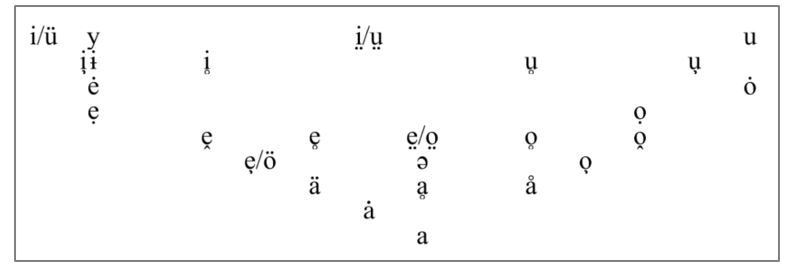
## Here and in most of the following figures I would strongly recommend imagefiles in higher resolution. Every figure should be provided with a caption, I would say ##
– sonorant system: ## is this the already harmonised system currently used in the SLA ? Perhaps make clearer ? ##
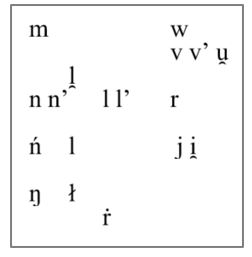
– obstruent system:
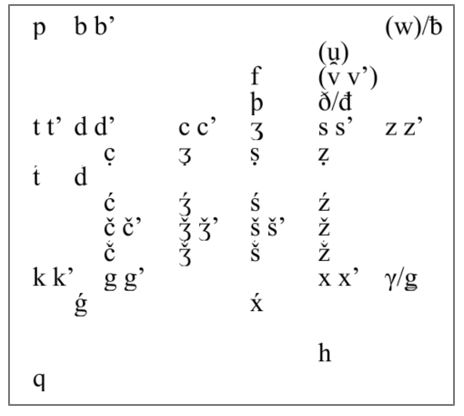
»##"##Since the SLA recordings did not consistently follow this agreement and the new transcription system only gradually came into force, it was not possible to harmonise the recordings of all material without a time-consuming re-examination on site.«##"## (SLA 2.2, p. 454) With the inconsistent recording of vowel quality and quantity, diphthongs and consonant variants, the recording of accentuation/intonation was the biggest problem.2 However – a retroactive harmonisation of the recorded dialect data would also require some experimental phonetic studies of the Slovene dialects. The lack of research in this area is also one of the reasons why ## the ? ##international phonetic transcription ## International Phonetic Alphabet - perhaps: " ... transcription in the International Phonetic Alphabet ... " ?? ## (IPA) has not yet been introduced in Slovene dialectology.
A comparison between Slovene (SLA), Slavic (OLA) and IPA transcription reveals some significant differences in the recording of phonetic variants of Slovene dialects, e.g.:
| SLA | OLA | IPA |
| Close vowels | ||
| i | i | i |
| #### passim | ||
| ü | | y |
| ɨ | ɪ | |
| y | | |
| | ||
| u | u | u |
| | ||
| | ||
| | ɨ | |
| | ʉ | |
| | ||
| ů | ||
| ẹ | ẹ/e | e |
| ḙ | e | |
| SLA | OLA | IPA |
| Accent and quantity | ||
| | : | ː |
| | | |
| | : | ː |
| | | |
| | ||
| Ṽ | | |
| / | V: | Vː |
| Vˑ | V | Vˑ |
| | V | V |
| SLA | OLA | IPA |
| Velars | ||
| k | k | k |
| k’ | k’ | kj |
| g | g | ɡ |
| g’ | g’ | ɡj |
| x | x | x |
| x’ | x’ | xj |
| γ | γ | ɣ |
| ǥ | ǥ | |
| ǵ | ǵ | |
| | | |
| γx | ||
| h | ĥ/h | ħ/ʕ |
| h | ||
| q | ʔ | ʔ |
| ʔ | ʔ | ʔ |
Therefore##,## it is difficult to rewrite/translate Slovene dialect material into IPA without some simplification and without further experimental phonetic studies – e.g. SLA prnca (ḙ is a neutral front/anterior closed-middle to open-middle vowel, ## the character used here (and presumably everywhere where a character is substituted by a square) is "not a valid unicode character" (-> https://www.fileformat.info/info/unicode/char/e534/index.htm ## is closed, anterior, tense, clear vowel i) ≠ IPA péːrnica, SLA cìẹǥu (ǥ is a fricative/spirantized g) ≠ IPA cìegu, SLA špa ( is an extra short ascending accent on vowel i) ≠ IPA ˈʃipa etc.
2.1.1. From phonetic to orthographic/standardised transcription in SLA
The data generalization (and thus the reduction of the excessive number of data symbols) makes the lexical maps clearer and more meaningful. In morphological analysis phonetically abstracted lexemes (according ## to ## the phonetic rules of each dialect, subdialect or even local dialect) are followed by their proto-Slavic##Proto-Slavic## transposition and their word-forming predecessors or foreign language sources (e.g. various Italian, Friulian, German, Hungarian or Croatian geolects, chronolects and sociolects). The orthographic transcription in SLA is thus based on the morphonological ## morphological ? ## analysis of dialect lexemes, e.g. - ## delete dash here? ## SLA V455.01 alpine meadow (Germ. die Alm, Slov. planina):
planína < *poln-in-a ← Psl. *poln-ъ ‘plane, without trees’
plánina < *poln-in-a ← PSl. *poln-ъ ‘plane, without trees’
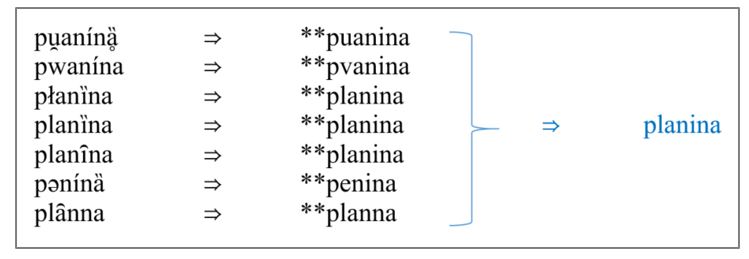
pašnik < *paš-ьn-ik-ъ ← *paš-ьn-ъ ← *paš-a (< *pas-j-a) ← *pas-ti ‘to pasture, to sheperd’ ## please use the "Konzept" button for concepts so that they appear in capital letters in the frontend -> to pasture, to sheperd- passim ##
pašnjak < paš-ьn-jak-ъ
spašnjak < *sъ-paš-ьn-jak-ъ ← *sъ(n)- ‘together with’ + *pas-ti
pasovnik < *pas-ov-ьn-ik-ъ
gora < *gor-a ‘mountain’ in ## what does "in" mean here resp. where is the point of "forest" here ? ## ‘mountain forest’
velika gora < *vel-ik-a-j-a gor-a ← *vel-ik-ъ ‘big’ + *gor-a
grič < *grič-ь/*gъrič-ь *## where is the point of using an asterisk here? can't refer to reconstructed form/word as reference is to concept; accordingly in the immediately following ##‘something like mountain’ / *‘small mountain’
breg < *berg-ъ ‘elevation, rising ground, hill, brink’
visoki breg < *vysok-ъ-j-ь berg-ъ ← *vysok-ъ ‘high’ + *berg-ъ
hrib < *xrib-ъ ‘crest, broad ridge’
hriber < *xrib-r-ъ
vrh < *vьrx-ъ ‘top, peak’
snežnik < *sněž-ьn-ik-ъ ← *sněž-ьn-ъ ← *sněg-ъ ‘snow’
gmajna < *(gmajn)-a ← MHG. gemeine ‘common community estate’
komunja < *(komuń)-a ← Friul. comugne ‘common estate’
paskulič < *(paskul)-i-ь ← Friul. pascul ‘pasture’
In the non-linguistic (e.g. Slovenian ethnological) literature other types of orthographic transcription could ## can ? ## be found, mostly based on a simplified phonetic transcription, that does not take into account various regular and irregular dialect phonetic changes, e.g., both plòh and pòh (with dialect development lo > o ## character !##> o) for ʻwashboard’ ## washboard ##, Standard Slovene perilnik, should be transcribed orthographically as ploh according to their morphological analysis:
ploh < *(plox)-ъ ← MHG bloch, bloc, Bavarian ploch ʻdeal board, log’ //
< *plox-ъ ʻflat, level piece of wood’, comp. ProtoSlavic *plosk-ъ
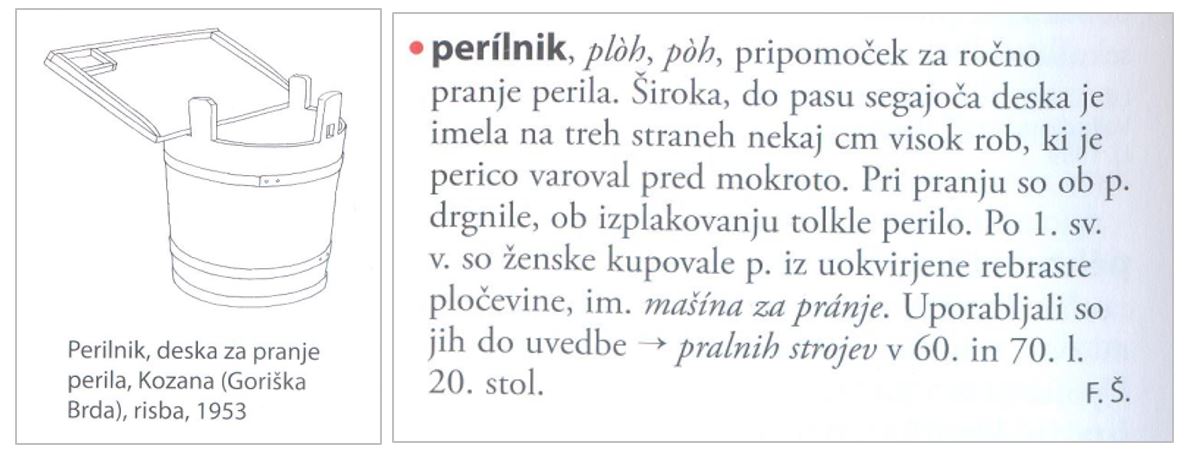
Source: Slovenski etnološki leksikon (Slovene ethnological lexicon). Ljubljana: Mladinska knjiga, 2004, p. 410. ## include in bibliography an use interactive link to bibl. here? ##
2.2. Transcription system in OLA
The work on the Slavic Linguistic Atlas##"Slavic Linguistic Atlas"## (Общеславянский лингвистический атлас - OLA ## -> bibliography! ##) is based on the decision of the 4th International Congress of the Slavists ## between quotes or italisize ? ## (Moscow, September 1958). The OLA Commission is represented by individual Slavic centers – one of which is also the only Slavic language in the Alpine region, namely Slovene (represented by the Scientific Research Center of Slovenian Academy of Sciences and Arts ## between quotes or italisize ? ##). ## insert line break here thus creating new paragraph ? ## The OLA questionnaire has 3454 questions and the number of research points (local dialects) is 850 (including 25 Slovene local dialects); dialect materials for ## the ? ## OLA were collected mainly in the years 1965-1975. The OLA publications are divided into two series devoted to 1. ## replace by "first" ? accordingly hereafter "2." -> "second" ?? ## lexical and wordforming maps and 2. grammatical, i.e. phonetic, morphological and syntactic maps. According to the conception of this edition, the OLA collective is divided into two ## are three ! ## parts: lexicon - wordformation and phonetics - grammar. One of the OLA subcommissions is responsible for the generalizing transcription of the field material - here the morphonological ## morphological ?? ## analysis of the Slavic dialect material is prepared, predictable phonological differentiations are eliminated and the general legend concepts for the lexical and word formation maps are prepared (more: <http://ola.zrc-sazu.si/OLB15ENG-uvod.htm> and <https://www.slavatlas.org/>).
For transcription of dialect material, the Slavic phonetic transcription is used in ## the ?? ## OLA:3
– vowel system:
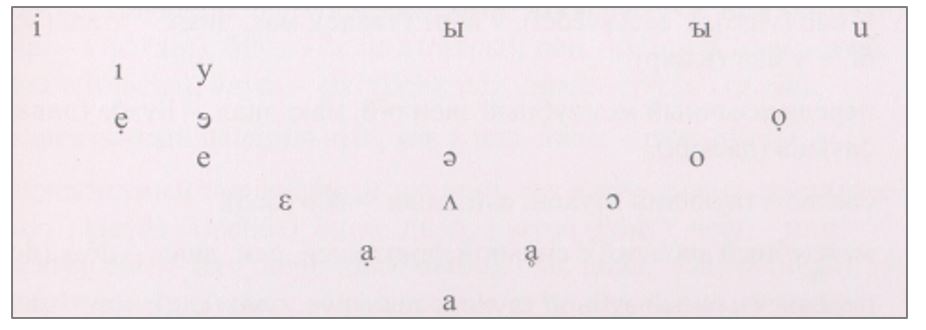
– consonant system:
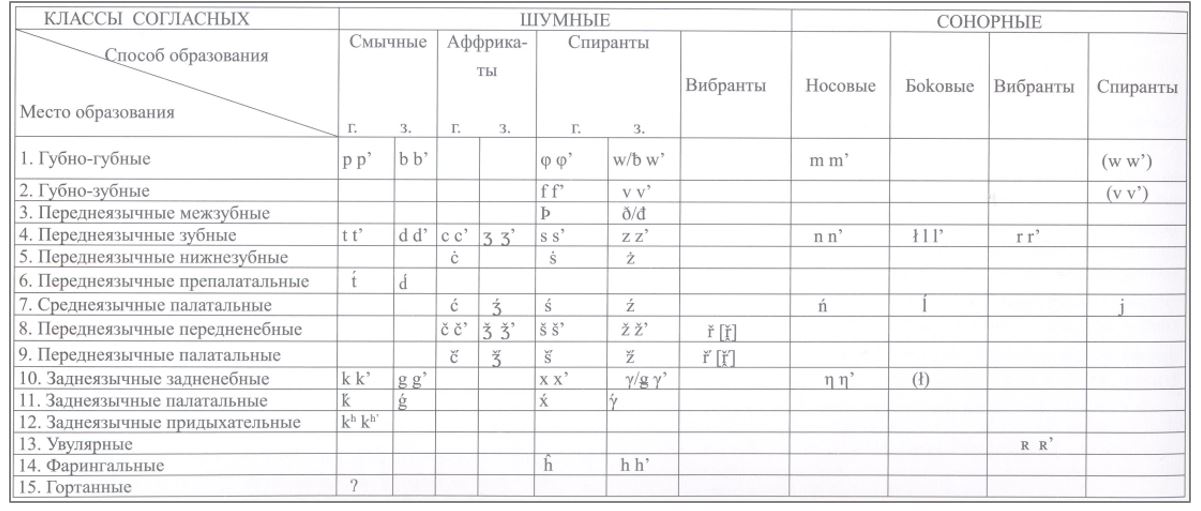
2.2.1. From an index to a legend in OLA
The orthographic transcription in OLA is also based on the morphonological ## morphological ?? ## analysis of dialect lexemes, e.g. - OLA 1901 кудрявый ‘curly (hair)’ ## CURLY (HAIR) ## (Germ. gelockt, Slov. kodrast) in Slovene dialects:
kodrast < *kǫdr-ast-ъ ← Proto##-##Slavic *kǫdr-ь, *kǫder-ъ *‘piece of spinning material’ (16 k ## character ##ːdrast, 21 ˈkundrḁsti) 4
kodrav < *kǫdr-av-ъ (17 ˈkuːdra##, 149 ˈkọndravi)
skodran < *sъ-kǫdr-a-n-ъ (17 skudˈrḁn) ←*sъ(n)- ‘together with’ + *kǫdr-ь, *kǫder-ъ
kuštrast < *kuStr-ast-ъ ← Proto##-##Slavic *kustr-ъ / *kustr-a (S > š) (16 k##ːštrast) ← ProtoSlavic *kust-ъ ‘bush, bundle, touf of hair’
rodljast < *rǫd-ьlj-ast-ъ ← Proto##-##Slavic *rǫd-ъ ‘curly’ (15 ˈruːdĺast)
zaročen < *za-rǫd-j-en-ъ ← Proto##-##Slavic *za- ‘behind’ + *rǫd-ъ ‘curly’ (6 zaˈručen)
zafrjen < *za-xv-j-en-ъ ← Proto##-##Slavic *za- ‘behind’ + onomatopoeic *xvъr (4 zaˈfərjen)
zafrkočen < * za-fъrk-ǫt-j-en / *za-xv-k-ǫt-j-en (20 zaf##ˈkọčen)
kravžast < *(kra##ž)-ast-ъ ← Germ. Bav. krausen ‘curl’ (147 ʔʀàː##žast)
kravžljast < *(kra##žlj)-ast-ъ ← Germ. Bav. krausel ‘curl’ (Germ. Kräusel ‘curl’) (13 kˈrḁːžlast, 14 kràːžlast, 19 kˈra##žlast)
skravžan < *sъ-(kra##ž)-a-n-ъ ← Germ. Bav. krausen ‘curl’ (7 skràː##žan, 8 skràː##žen, 9 skràː##žan, 10 skˈraː##žan, 18 skˈraː##žan, 147 sʔʀàː##žan)
skravžljan < *sъ-(kra##žlj)-a-n-ъ ← Germ. Bav. krausel ‘curl’ (Germ. Kräusel ‘curl’) (146 skràžlan, 13 skˈrọžlan, 16 skrːžlen, 19 skˈražlan, 148 sʔràːžlan)
ričast < *(rič)-ast-ъ ← Ital. riccio ‘curly’ (11 ˈriːčast)
ricast < *(ric)-ast-ъ ← Ital. Ven. rizo (for Ital. riccio) ‘curly’ (3 ˈricəst, 5 ˈriːcast, 12 ˈriːcast)
ricotast < *(ricot)-ast-ъ ← Friul. riçot (*rizot) ‘curl’ (2 ricóːtast)
čafarunast < *(ćavelun)-ast-ъ ← Friul. cjavelon ‘long-haired’ (1 čafaˈrunest)
2.3. Transcription system in ALE
The origins of the European Linguistic Atlas##"European Linguistic Atlas"## (Atlas linguarum Europae##"Atlas linguarum Europae"## - ALE project ## link with https://www.wikidata.org/wiki/Special:EntityPage/Q2869438 ?! ##) date back to 1965, when the realization of a European linguistic atlas was proposed at the International Geolinguistics Congress in Marburg. In 1970, the project was put under the UNESCO direction and represents the first and so far only research project of this dimension in the field of linguistics. The ALE questionnaire has 546 questions and the number of research points (local dialects) is 2631 (including 9 Slovene local dialects).
For the transcription of dialect material ALE uses an adopted international phonetic transcription:5
– vowel system:
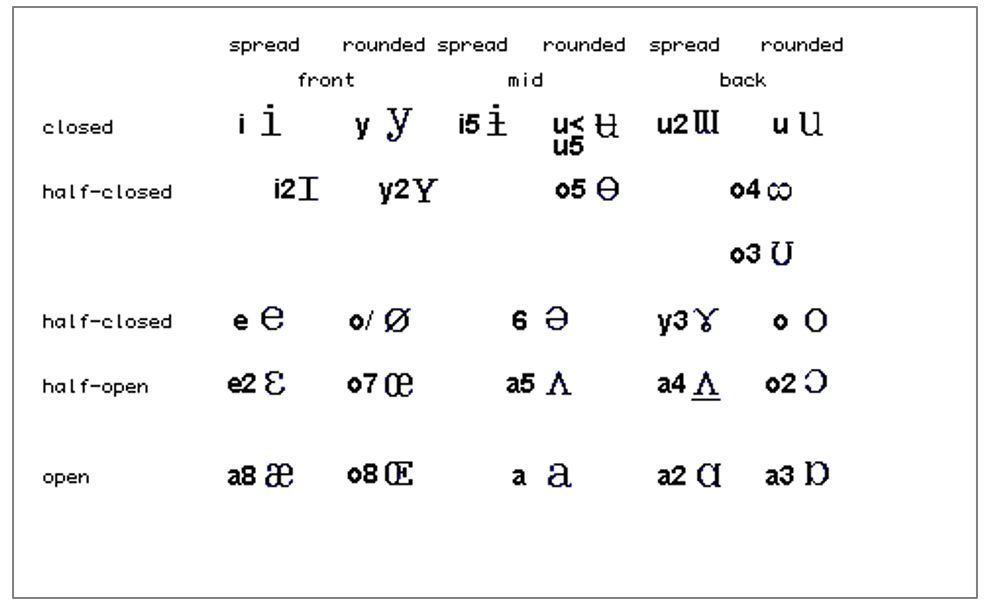
– consonant system and diacritics:
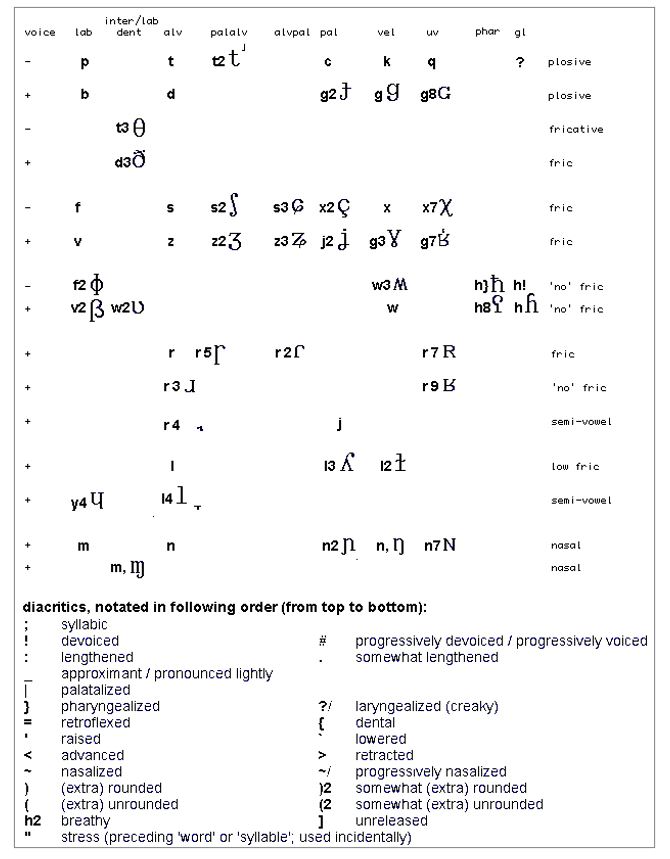
The orthographic transcription in ## the ?? ## ALE depends on different transcription traditions in the languages involved in the project, e.g. ALE ‘potato’ ## potato ## (Germ. Grundbirne, Erdapfel, Kartoffel, Slov. krompir) in Austrian and Slovene net-points##survey points/elevation points?##:
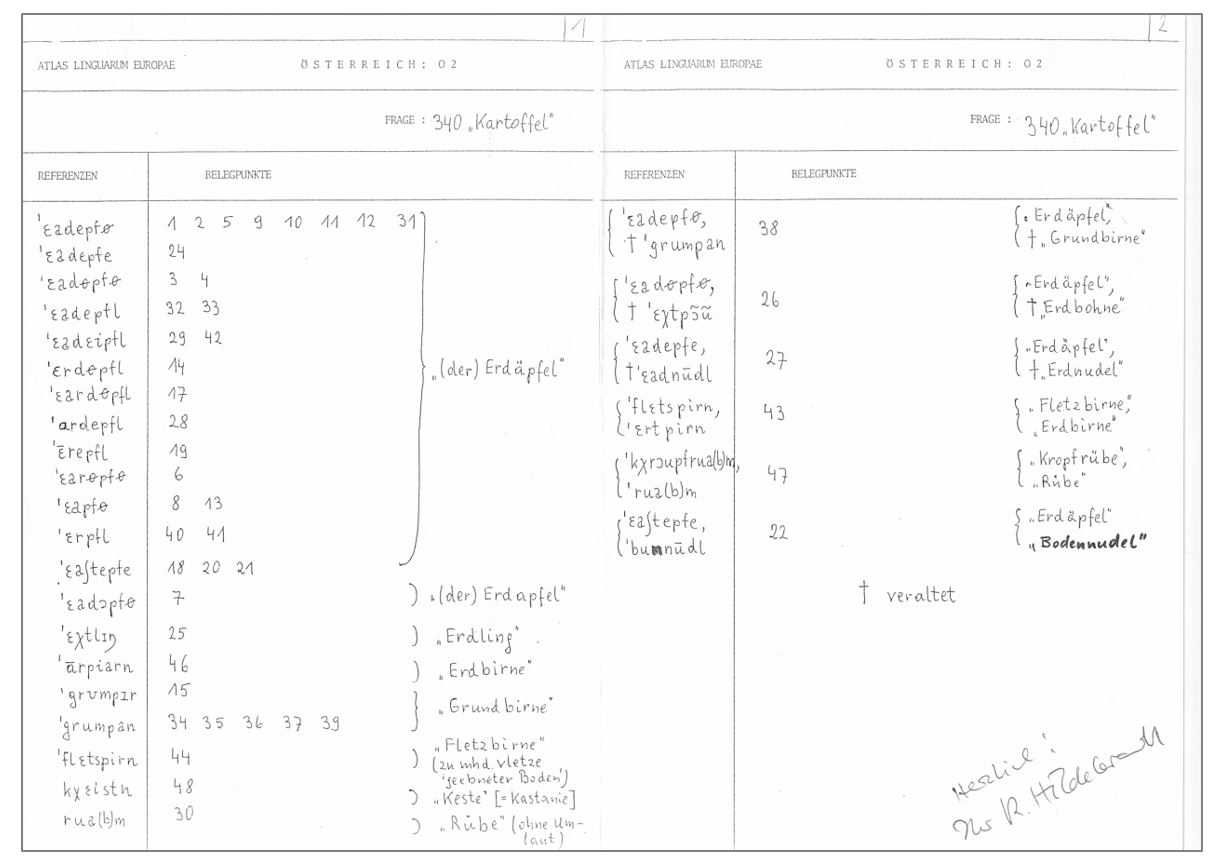
Dialect material for ALE 340 ‘potato’ in Austrian net-points##survey points/elevation points?##
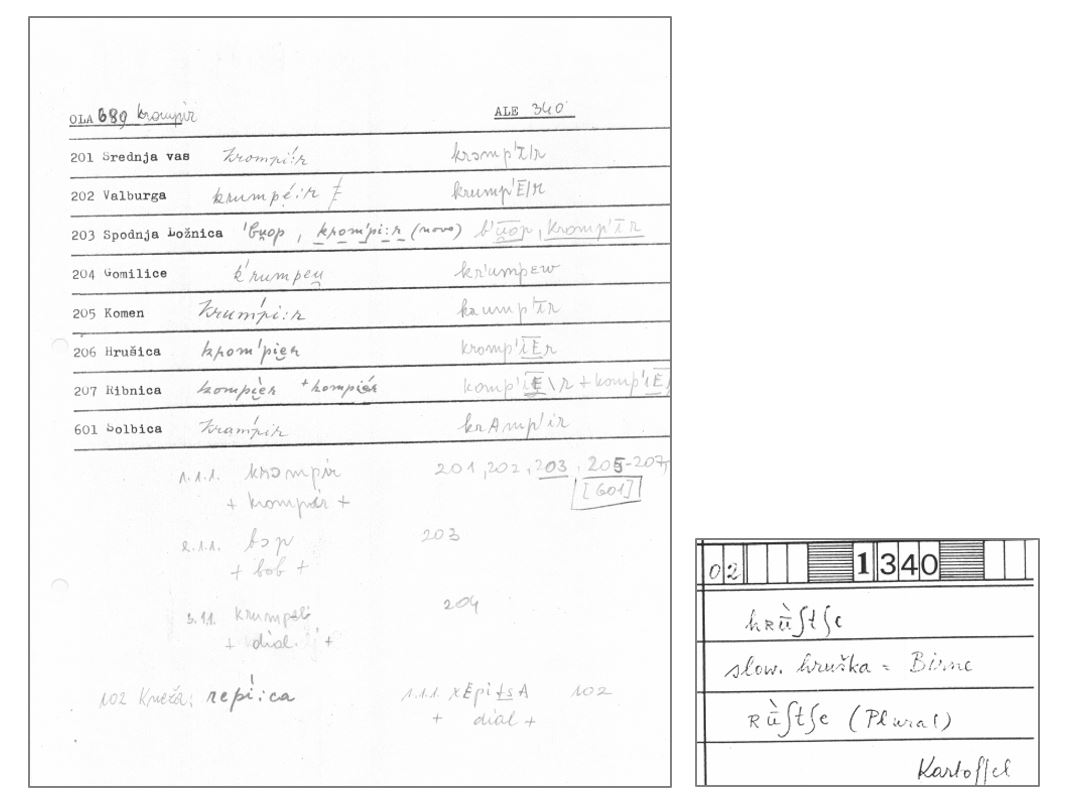
Dialect material for ALE 340 ‘potato’ in Slovene net-points##survey points/elevation points?##
3. Database
All the above mentioned projects use different databases for storing and processing the collected data. The manuscripts of the collected dialect materials are mainly stored in the traditional project collections of the participating research centers, which will be gradually digitized.
3.1. SLA Slovene Linguistic Atlas
## The ## Slovene Linguistic Atlas##"Slovene Linguistic Atlas"## database SlovarRed is designed in Access ## make clear what is meant by Access here -> "Microsoft Access" - additionally link to https://www.wikidata.org/wiki/Special:EntityPage/Q80689 !? ## with many relational subcharts (net-points##survey points/elevation points?##, their codes and geographical names as well as the geographical coordinates of the net-points##survey points/elevation points?##, the names of the recorders, the years of the recording, the form (notebook, card paper, pdf file) of the recording, the reliability of the recording, the answer in phonetic transcription, etc.). The SlovarRed database enables ##the## connection with the scannings of the traditional archive notes and ##the## connection with ArcGIS ## link to https://www.wikidata.org/wiki/Special:EntityPage/Q513297 ?! ##.
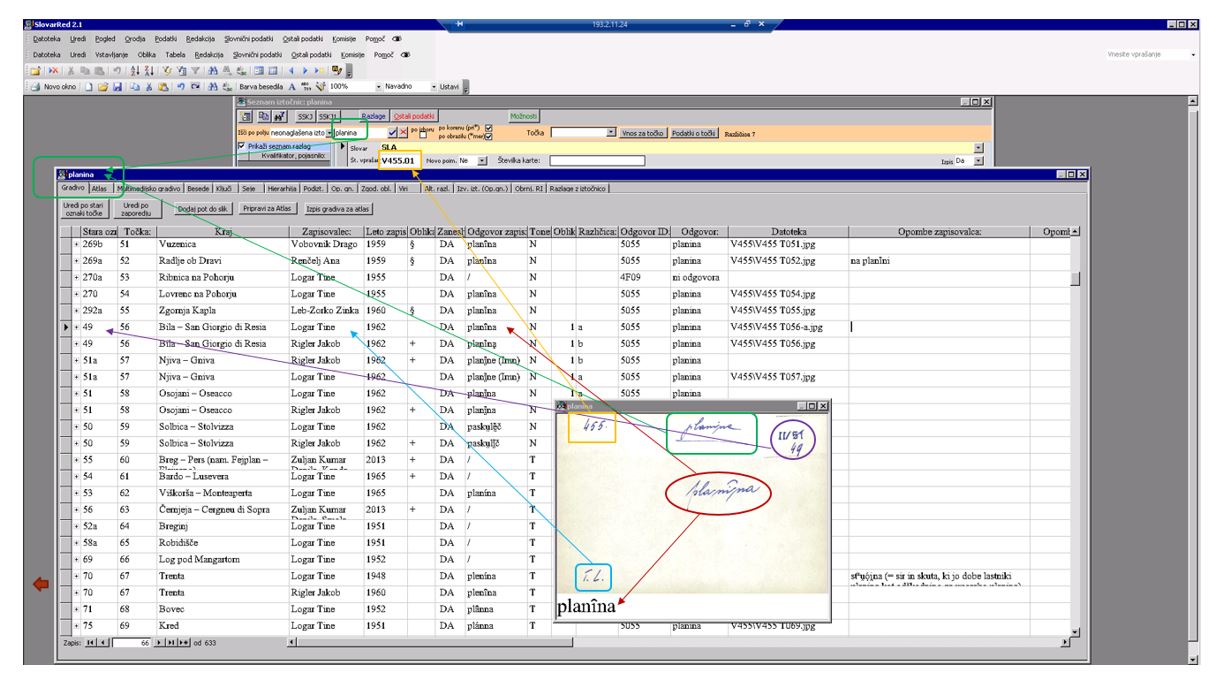
SLA database: SlovarRed (Access): V455.01 planina ʻalpine meadow’
The list of symbols and their numerical codes (SIMBola font) is one of the subcharts of SlovarRed for preparing legends of maps.
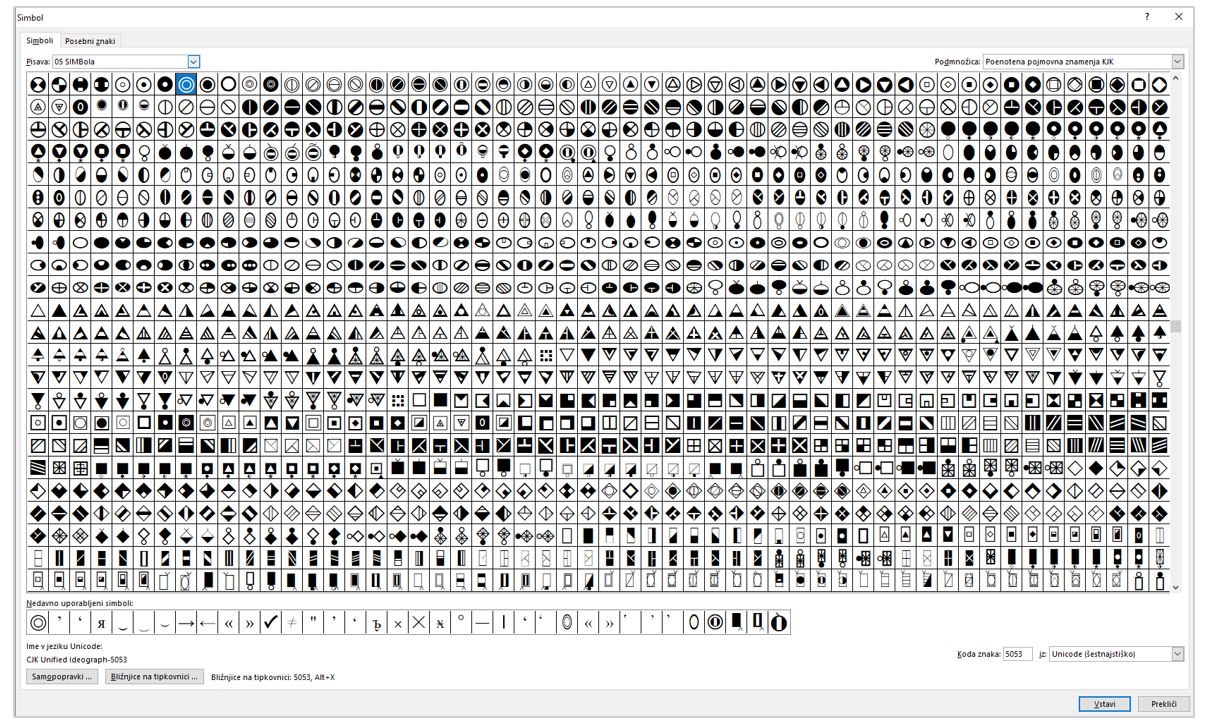
SIMBola
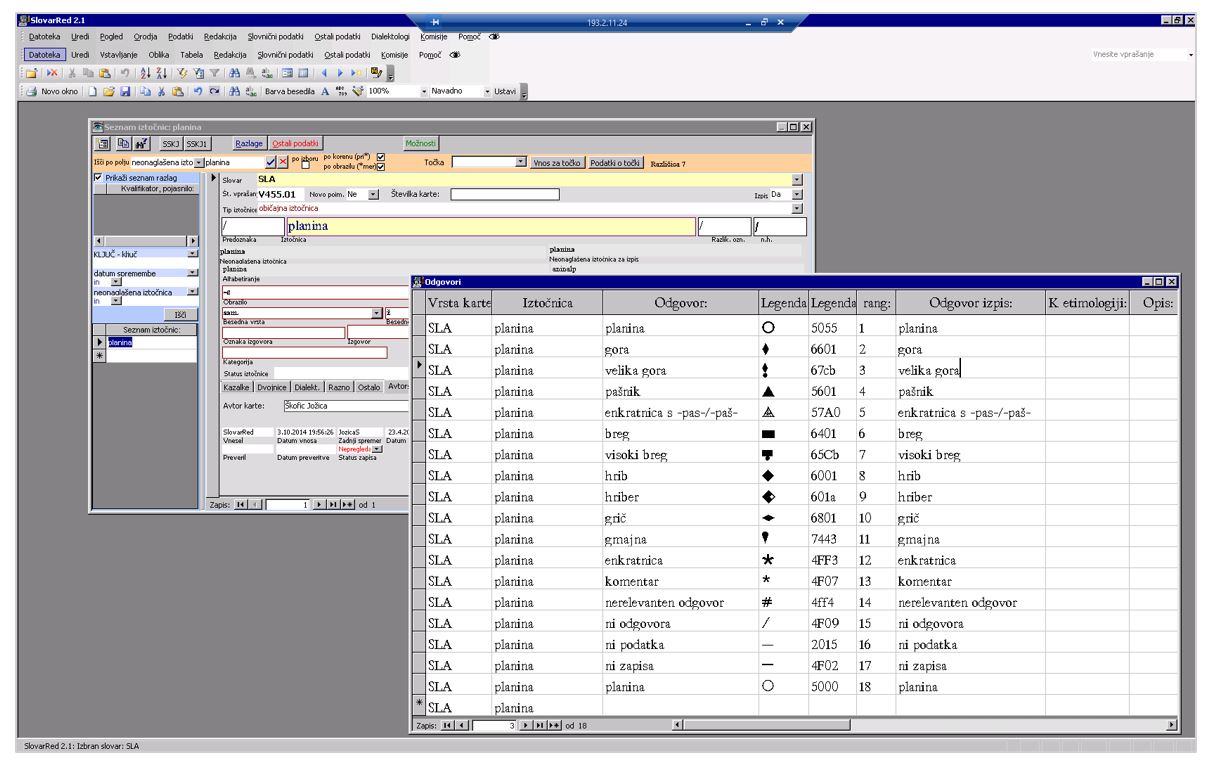
Legend for V455.01 planina ʻalpine meadow’ ## upper case ##
3.2. OLA
Tha database for ##the## Slavic Linguistic Atlas##"Slavic Linguistic Atlas"## uses Excel ## "Microsoft Excel" and link to wikidata object ? ##, which contains the data of the net-points##survey points/elevation points?## such as geographical names and codes/numbers of net-points##survey points/elevation points?##, the name of the country (Пункт), an answer in phonetic transcription (Материал), the numerical code of the symbol and its position on the printed map (L1, L2, P1, P2), commentary (Морфонология) etc. The database is not connected to GIS ## "to a GIS" ? ##.
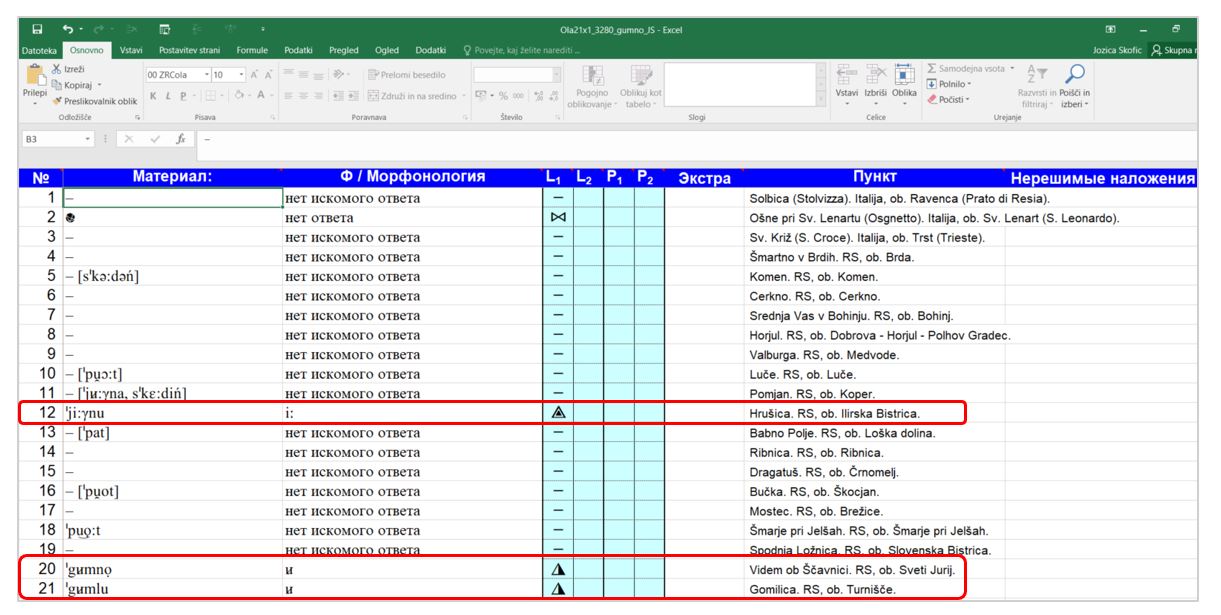
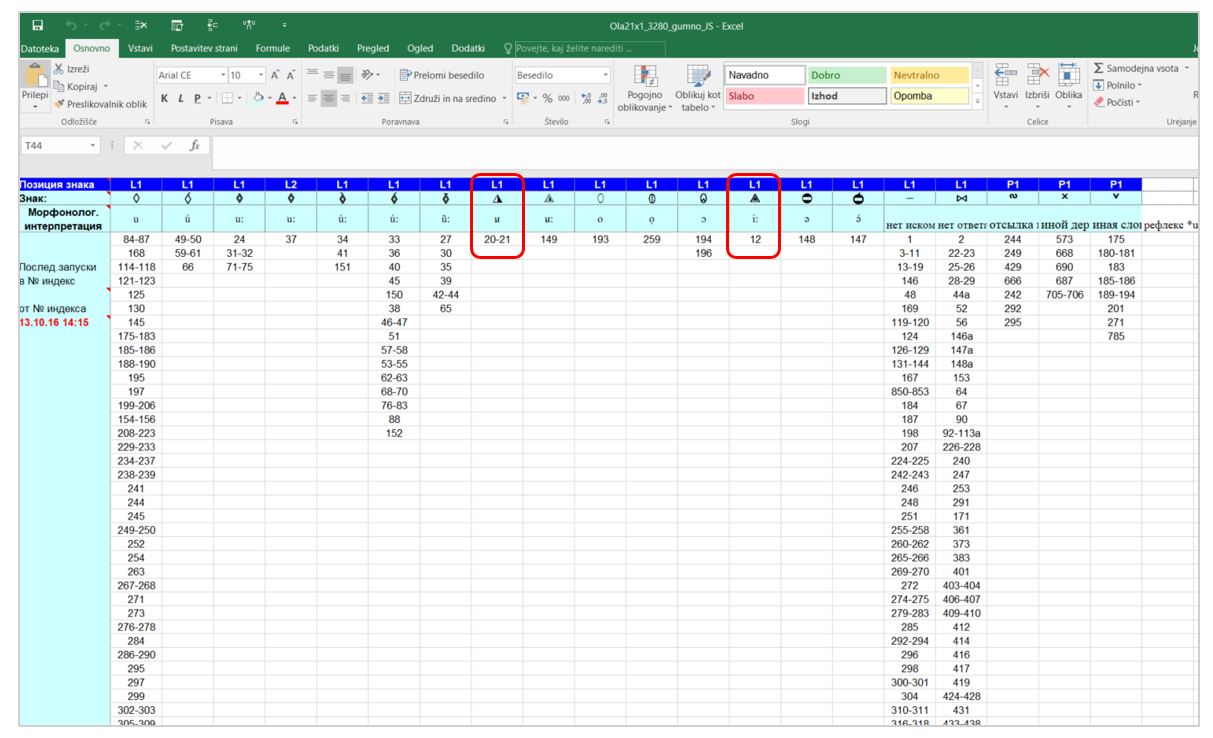
##The## OLA database (Excel): 3280 *u in PSl. *gumьn-o, Slov. gumno ʻbarn’
3.3. ALE
A database for the European Linguistic Atlas##"European Linguistic Atlas"## uses Excel ## specify -> see above ##, in which columns are provided for different data: A) net-points##survey points/elevation points?## (code for country, language, net-point##survey point/elevation point?##), B) name of language, C) answer in orthographic transcription, D) answer in phonetic transcription, E) commentary (i.e. ethymology etc.), F) symbol, G) numerical code of symbol (SIMBola). The database is not connected to GIS. ## "to a GIS" ? ##
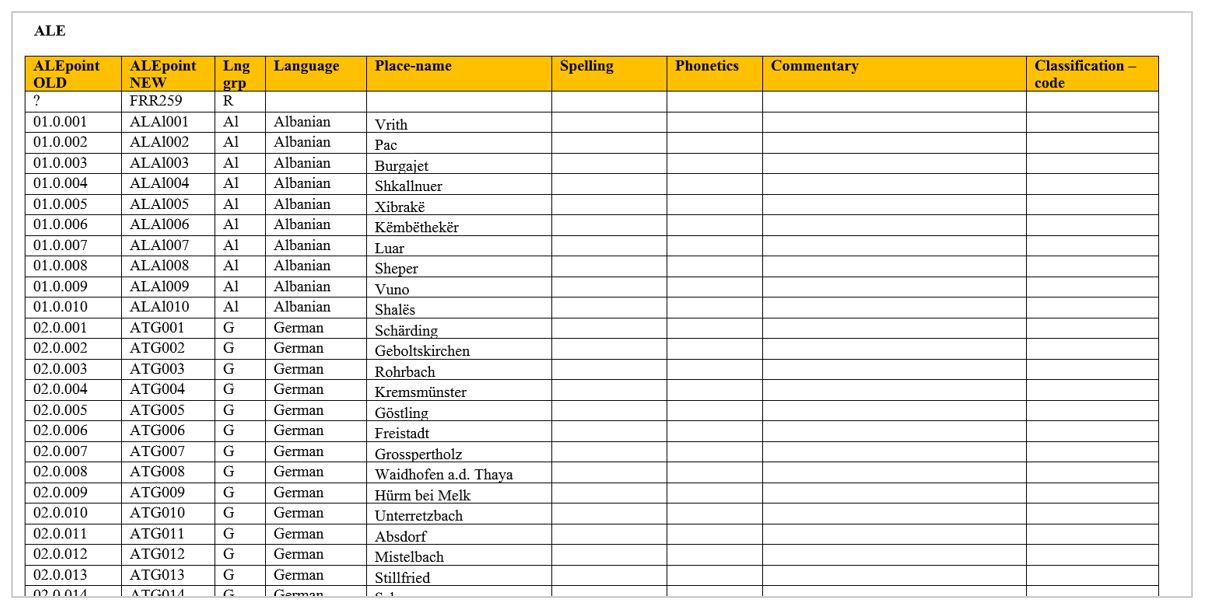
The beginning of ##the## ALE database

##The## ALE database (Excel): Slovene answers for Qu. 050 ʻspruce’: net-point##survey point/elevation point?## code – language – orthographic transcription - ALE phonetic transcription – etymology and motivational analysis - symbol code - symbol
4. Maps
All three projects, SLA, OLA and ALE, use symbols to represent dialect material on the maps. However, the programme ##programming?## tools they use to place symbols on the map are very different.
4.1. SLA
The SLA project is an interdisciplinary project, which not only involves linguistics (the linguists have to complete the database by collecting dialect material, preparing synchronic-diachronic linguistic analysis and geolinguistic presentation of dialect lexemes), but also other disciplines such as geography, i.e. cartography, spatial analysis of data, GIS. A specialist of the Institute of Anthropological and Spatial Studies at ZRC SAZU prepared the georeferencing of all data, while cartographers of the Anton Melik Geographical Institute at ZRC SAZU prepared suitable cartographic bases for the geolinguistic presentation of dialect material, i.e. e-maps ## better?: electronic maps ##, which are accessible to all project members.
Common guidelines for the presentation of dialect data on the maps have been agreed. »A special hierarchy of symbols has been formulated in the Slovenian Linguistic Atlas##"Slovenian Linguistic Atlas"## ## Link to Bibliography?! Bibliographic description at (???) not complete; change abbreviation to "SLA" ? ## based on the deliberate and established practice of the Slavic Linguistic Atlas##"Slavic Linguistic Atlas"##. The symbols were mainly chosen by the authors of the maps themselves, in line with the agreement that the outline of the symbols should indicate the root of the lexeme and the inner part the word-formational construction of the lexemes. The choice of symbol was based on the morphological analysis«6 (see map for ʻalpine meadow’ ##alpine meadow ## below). Lines on the maps are used to represent morphological and phonetic features (see the map for SLA V573.01 gnoj ʻmanure’ ##manure## in SLA 2.1, 163), while words and lines together are used only when no lexical differentiation (besides phonetic) is noticed. Colours represent a semantic differentiation (see the map for SLA V153B.01 ʻpocket knife’ in SLA 2.1, 131).
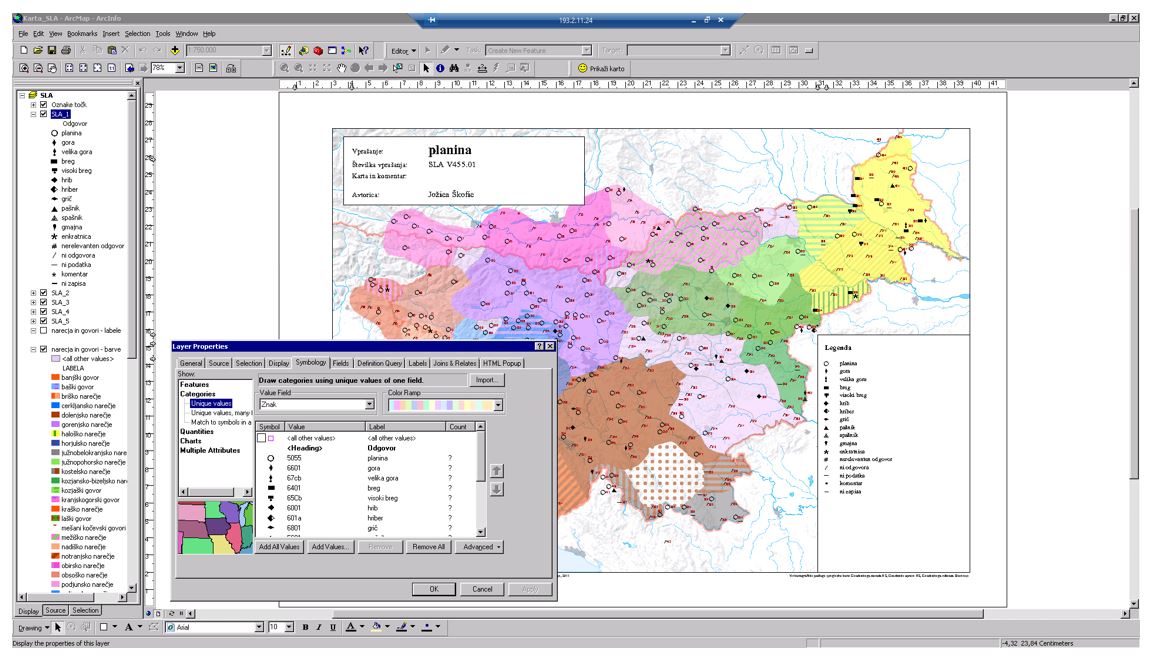
ArcGIS (ArcMap ## what is "ArcMap"? ##) – SLA V455.01 planina ʻalpine meadow’ ## upper case ?! ##
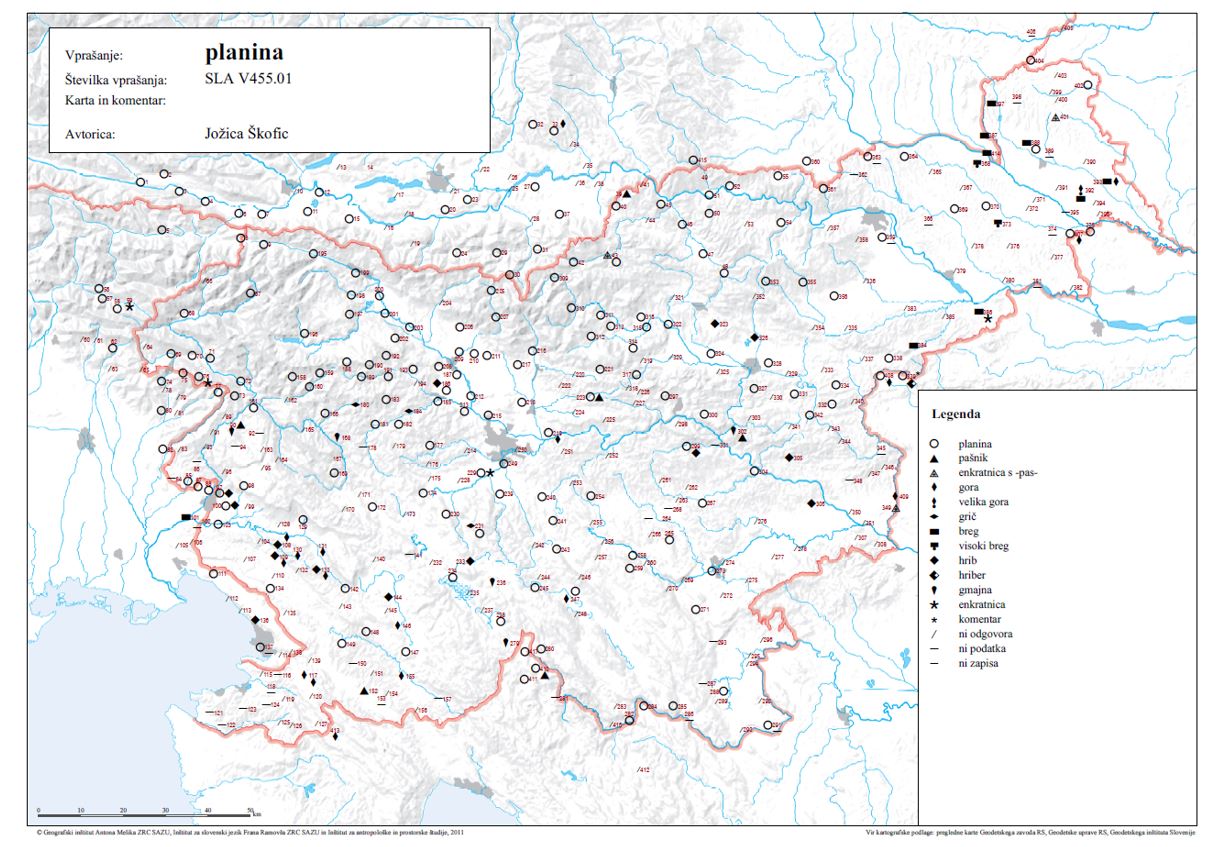
Map SLA V455.01 planina ʻalpine meadow’ ## upper case ?! ## (prepared with SlovarRed and ArcGIS)
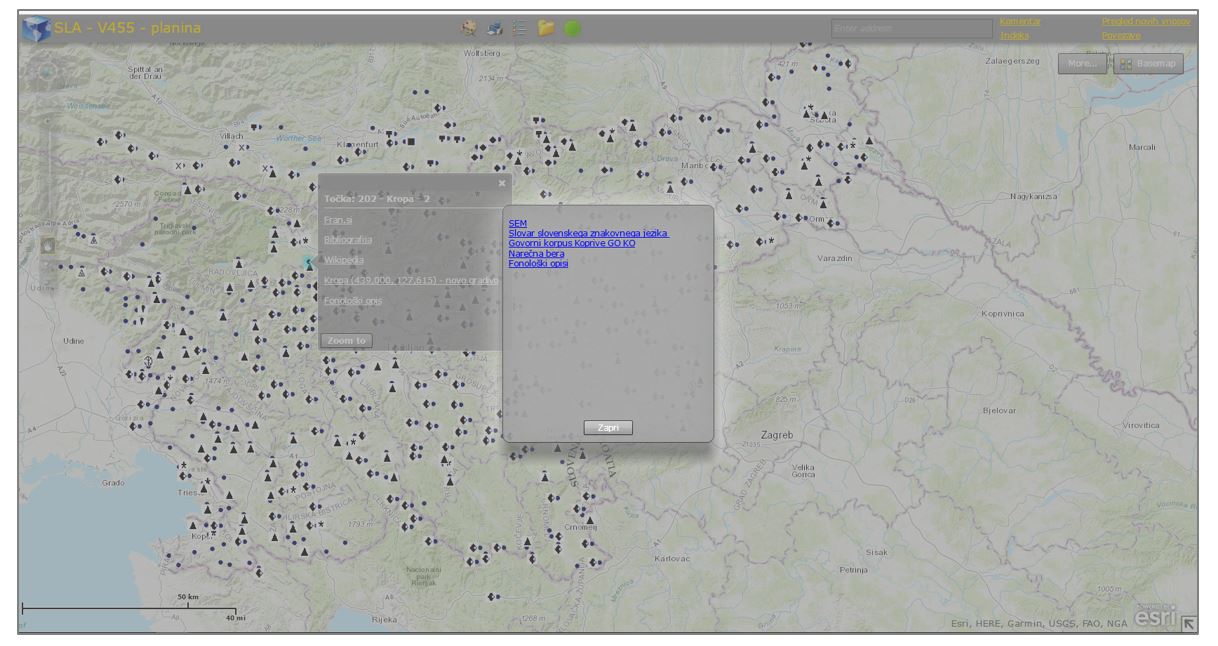
Test interactive linguistic map for SLA V455.01 planina ʻalpine meadow’ ## upper case ?! ##
(Source: <http://gismo.zrc-sazu.si/flexviewers/Test_Vicic/SLA1/SLA_planina1/> ## Adobe Flash Player required -> mention ? ##)
4.2. OLA
The mapping with symbols in ##the## SLA follows the principles of the international OLA project. In contrast to the SLA, OLA ## delete OLA here? -> sentence! ## the programme ## program ? ## MapOLA has been used in the last years, which has been developed at the Jazykovedný ústav Ľudovíta Štúra (Ľ. Štúr Institute of Linguistics) of the Slovak Academy of Sciences. It does not use GIS ## what is meant with GIS here? Georeferencing? ##, but places symbols directly into the pdf of the blank (empty) map.
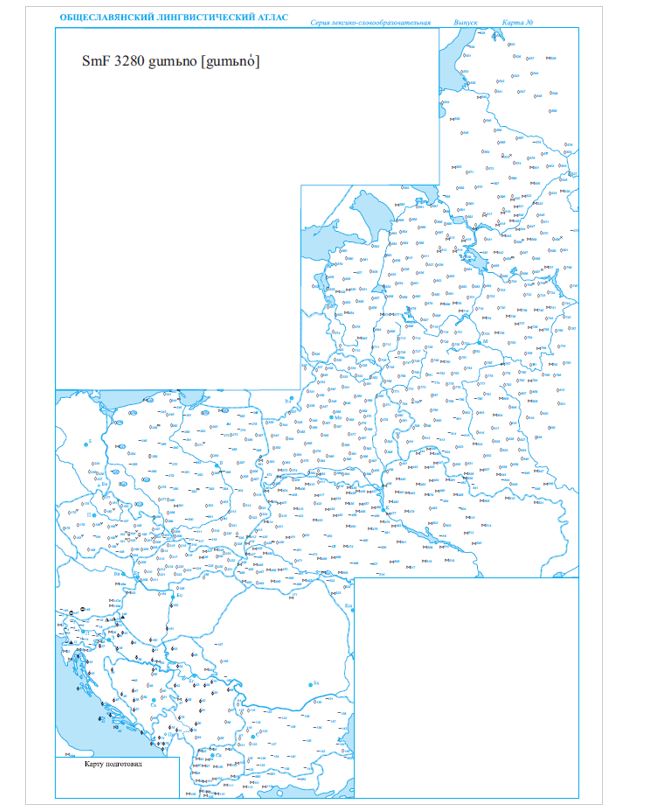
Experimental map for *u (in PSl. *gumьn-o, Slov. gumno ʻbarn’) in Slavic languages (J. Škofic, 2020 ## missing in bibliography. Add and use interactive Link to entry in Bibliography? -> "Literaturangabe" ##)
4.3. ALE
The ALE project has undergone various types of mapping over the last decades – volumes 5 to 7 ## add to bibliography?! ## were printed by the Instituto Poligrafico and the maps were produced by cartographers in Rome on the basis of the legends prepared by the authors of the commentaries. The authors themselves could not prepare any maps for their commentaries (except to draw symbols manually on a printed blank map to test a selection of symbols). In recent years, the geolinguists and computer scientists of the Romanian Academy (as president of ALE is Prof. Dr. Nicolae Saramandu from Bucharest) have developed a mapping tool Surfer 8, which allows the electronic drawing of symbols on the empty map (pdf) when a complex legend for each of the participating countries and languages is created in Excel. However, the linguists cannot draw their maps themselves, so the collective ## team ?## is still looking for a better solution.

Surfer 8, Excel database for the legend for Slovene net-points##survey points?/elevation points?##
5. Conclusion
Cooperation between linguists and language technologists of all project partners is essential as information technology can prepare technical updates of databases, the incorporation of the analysed dialect material into different language portals (such as <https://www.fran.si>) and the preparation of programme ##programming?## tools for interactive linguistic atlases and the involvement of citizens in the electronic collection of dialect material through crowdsourcing as well as the linking of language knowledge presented on electronic linguistic maps and ##made## accessible via the Internet with other open electronic sources##sentence is too long! Please make two or three out of it!##. We should also reach a joint agreement with the project Verba Alpina##"VerbaAlpina"## for the unification of the transcriptions, databases and mapping tools in order to efficiently link different projects. It would be very beneficial if the project partners could prepare a common tool, that is also useful for other geolinguistic projects (regional, national, international ##ones## ...). This would allow an easier integration of Slovene material into this international geolinguistic project, whose one of final goals is the synthesis of research on the linguistically, culturally, politically etc. fragmented Alpine region.##...which aims, among other things, to synthesise research on the linguistically, culturally, politically, etc. fragmented Alpine region. OR: ...whose main goal is...##
And finally – does the SLA meet FAIR requirements? It is findable (the easiest and most well-known way is to search on the Fran portal – dictionaries of the ISJFR ZRC SAZU at <https://www.fran.si/iskanje?FilteredDictionaryIds=204&View=1&Query=%2A&FilteredDictionaryIds=204&View=1&Query=%2A>), it is accessible (<https://sla.zrc-sazu.si/#v>) and it wants to be interoperable because it is highly reusable. Thus - it is just »FAiR«##"FAIR"##.
Bibliography
- Bureau de la Rédaction – Nijmeegse Centrale voor Dialecten Naamkunde 1972 = Bureau de la Rédaction – Nijmeegse Centrale voor Dialecten Naamkunde (1972): Atlas Linguistique de l’Europe: proposition du Premier Questionnaire, Nimègue (Link).
- Fran dictionaries 2014- = ZRC SAZU (2014-): Fran, dictionaries of the Fran Ramovš Institute of the Slovenian Language ZRC SAZU, version 6.0 (Link).
- Izdatel’stvo »Nauka« 1965 = Izdatel’stvo »Nauka« (1965): Voprosnik Obščeslavjanskogo lingvističeskogo atlasa, Moskva, Izdatel’stvo »Nauka« (Link).
- Škofic, et al. 2016 = Škofic, et al. , Jožica (2016): Slovenski lingvistični atlas. 2, Kmetija, 1 Atlas (SLA 2.1), Ljubljana, Založba ZRC, ZRC SAZU.
- Škofic, et al. 2016b = Škofic, et al. , Jožica (2016): Slovenski lingvistični atlas. 2, Kmetija, 2 Komentarji (SLA 2.2), Ljubljana, Založba ZRC, ZRC SAZU.
- Skok/Jonke 1971-1974 = Skok, Petar / Jonke, Ljudevit (1971-1974): Etimologijski rječnik hrvatskoga ili srpskoga jezika I: A–J, 1971; II: K–poni1, 1972; III: poni2–Ž, 1973; IV: kazala, 1974, Zagreb, Jugoslavenska akademija znanosti i umjetnosti.
- SLA = ZRC SAZU: Slovenian linguistic atlas (Link).
